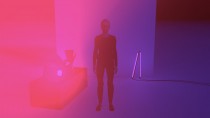While We Sink Ships is fundamentally a photographic collaboration, it has always, from its very beginning, been closely associated with music and sound. There are, I’m sure, many reasons for this, though, in short, Heidi and I are music fans. It is hard then for the music we listen to, and in my case compose, not to infuse itself in everything we do and therefore in We Sink Ships. As the project began evolving, music and sound took on an increasingly creative role in our collaboration. For instance, I began creating an embryonic hybrid of minimalist classical music and ambient soundscapes to accompany the visual art – this would eventually spawn my musical solo project “beneath us, the waves”. Among other projects, we planned to produce a series of “radio shows” and we considered several implementations of broadcasting. In our first months, we created and uploaded ad-hoc DJ mixes (crudely presented on Google video) and we began to investigate online streaming radio, however, the costs involved and overall effort required became prohibitive. As in many things, the best solution is often the simplest and we began podcasting through Glasgow’s online radio station, Radio Magnetic, at the beginning of this year.
In “‘Casting off…”, I thought I might look at the genesis, evolution and the future of our podcast and how it allows We Sink Ships the opportunity to interact with peers and its audience alike.
‘Casting off…
In 2004, an Apple-obsessed friend began enthusing over a new medium that would “one day sideline radio in the same way digital media put vinyl on the shelf”, to be enjoyed by only the fervent enthusiasts. The medium was podcasting and I was intrigued. Podcast, a trendy portmanteau blending Apple’s “pod” motif with the idea of broadcasting to the world, is now as pervasive in our online world as Mozilla’s Firefox, Facebook pages or Twitter ids. Podcasts are so popular, in fact, that almost all UK radio stations offer selected content and they are lauded by Stephen Fry, Ricky Gervais and Frankie Boyle among many other celebrity podcasters. As it allows direct access to an audience, governments, corporations and NGOs all have adopted the medium. There are a wealth of podcast genres including sport, news, comedy, education and they even come, occasionally, in a video flavour. Podcasts allow a democratising of radio broadcasting. Anyone with a computer, a microphone and a decent audio editing package can prepare an audio podcast in little time and more and more private individuals, and importantly artists, musicians and other creatives are getting involved.
We Sink Ships is made from two strong musical identities and we knew it would be difficult to blend these together every week so we devised a format that would make the podcasts easier to present and to enjoy – in addition to a guest DJ set and selection of classical and ambient music, Heidi and I would create our own mix each month. Our next consideration was that alongside our mixes of music, we wanted the opportunity to recommend things that are important to us, to our audience. We reduced each mix to 45 minutes leaving us with 15 to talk about things that excited us. In forming our concept we realised that introducing and interviewing guests provided both ease of production and added a dynamic element to the show in that occasionally, there were voices other than ours that would appear.
After only one podcast produced, I complicated matters by emigrating to Warsaw and this introduced new challenges into the way the show is created. With the technology now available, in 2010 it is much easier to continue such a project split by 1000 miles than it would have been, say, 20 years ago. Email, social networking, voice-over-ip software and reasonably cheap audio hardware all combine to make such a change feel seamless.
A major criterion in the formation of the podcast series was interaction with our audience and with our peers. We were keen on provoking discussion with our members and created a “top 5s” feature for this purpose. The choices that Heidi and I make are presented on the podcast and we then hope the listeners will use our blog to give us theirs. The podcast also allows us to highlight to our listenersnew exhibitions available on our website or to promote exhibitions by other artists and photographers among other things – this month, for instance, we have taken the opportunity to focus on this very community with an interview with Damien Smith.
What of the future? Our interaction with our listeners will continue and we are planning collaborative projects in both visual art and sound that can be coordinated and ultimately exhibited either on our website or on the podcast itself. We have been prudent enough to plan our content several months in advance but in the second half of this year I would like to see us using the podcast medium to branch out into one-off collaborations with other podcasters, blogs, artists, film-makers Podcasting offers a singular opportunity to create stand alone “We Sink Ships presents…” episodes and it would be silly not to take advantage of this. What is already clear is that at 6 years old, the podcasting medium, compared to radio at least, is still in its infancy and will surely grow and grow. As many more creatively minded individuals begin using it to enhance their – and their audience’s – artistic experience, fresh and unique uses of the medium will serve to give rise to original and exciting projects and collaborations.
Neil Milton
–
We Sink Ships is Heidi Kuisma & Neil Milton
Podcast Episode 2.1 – Central Station (interview with Damien Smith)
/////
Mix-Blog: A bit like a mix-tape but with blogs instead. Read more from the series here.














Comments